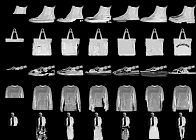Image GPT
PyTorch implementation of Image GPT, based on paper Generative Pretraining from Pixels (Chen et al.) and accompanying code.


Model-generated completions of half-images from test set. First column is
input; last column is original image
Differences from original paper:
- Uses 4-bit grayscale images instead of 9-bit RGB
- 28x28 images are used instead of 32x32
- Quantization is done naively using division, not KNN
- Model is much smaller and can be trained with much less compute
According to their blog post, the largest model, iGPT-L (1.4 M parameters), was trained for 2500 V100-days. By greatly reducing the number of attention head, number of layers, and input size (which effects model size quadratically), we can train our own model (26 K parameters) on Fashion-MNIST on a single NVIDIA 2070 in less than 2 hours.
Usage
Pre-trained Models
Pre-trained models are located in models directory.
Prepare Data
To download and prepare data, run src/prepare_data.py. Omitting the --fashion
argument will download normal MNIST. Images are downloaded and encoded with a
4-bit grayscale pallete.
python src/prepare_data.py --fashionTraining
Models can be trained using src/run.py with the train subcommand.
Generative Pre-training
python src/run.py train --name fmnist_genThe following hyperparameters can also be provided. Smallest model from paper is shown for comparison.
| Argument | Default | iGPT-S (Chen et al.) |
|---|---|---|
--embed_dim |
16 | 512 |
--num_heads |
2 | 8 |
--num_layers |
8 | 24 |
--num_pixels |
28 | 32 |
--num_vocab |
16 | 512 |
--batch_size |
64 | 128 |
--learning_rate |
0.01 | 0.01 |
--steps |
25000 | 1000000 |
Classification Fine-tuning
Pre-trained models can be fine-tuned by passing the path to the pre-trained
checkpoint to --pretrained, along with the --classify argument. I have found
a small reduction in learning rate is necessary.
python src/run.py train \
--name fmnist_clf \
--pretrained models/fmnist_gen.ckpt \
--classify \
--learning_rate 3e-3Sampling
Figures like those seen above can be created using random images from test set:
# outputs to figure.png
python src/sample.py models/fmnist_gen.ckptGifs like the one seen in my tweet can be made like so:
# outputs to out.gif
python src/gif.py models/fmnist_gen.ckpt